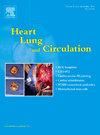Short- and Long-Term Outcomes of Obstructive and Non-Obstructive Hypertrophic Cardiomyopathy: A Systematic Review and Meta-Analysis
IF 2.2
4区 医学
Q2 CARDIAC & CARDIOVASCULAR SYSTEMS
引用次数: 0
Abstract
Background
Hypertrophic cardiomyopathy (HCM) is the most common inherited cardiac condition, but the risk factors and outcomes of patients with obstructive (HOCM) and non-obstructive hypertrophic cardiomyopathy (NOCM) remain unclear. This systematic review and meta-analysis was conducted to investigate the risk ratio (RR), incidence, and risk factors of all-cause and HCM-specific mortality.
Methods
This PRISMA-adherent systematic review involved a systematic search of PubMed, SCOPUS, and Embase for studies published from 1 January 2001 to 31 August 2023 that reported outcomes of patients with HOCM and NOCM. Random effects meta-analyses and meta-regressions were used for primary analysis.
Results
Sixty-one observational studies with 52,020 participants were included. All-cause, HCM-related, and heart failure-related mortality had no difference in HOCM vs NOCM patients (RR 0.85, 95% CI 0.58–1.25), (RR 0.95, 95% CI 0.68–1.32), and (RR 0.95, 95% CI 0.58–1.58), respectively. Sudden cardiac death (SCD) was significantly higher in HOCM vs NOCM patients (RR 1.69, 95% CI 1.19–2.42). Incidence of all-cause mortality (NOCM 95.47, 95% CI 63.96–140.18 vs HOCM 65.75, 95% CI 48.04–89.37) per 1,000 observations, HCM-related mortality (NOCM 59.72, 95% CI 41.91–84.42 vs HOCM 55.51, 95% CI 39.42–77.64), and SCD (NOCM 32.17, 95% CI 22.42–45.96 vs HOCM: 25.39 95% CI 15.24–42.01) were higher in NOCM patients, while heart failure-related mortality (HOCM 55.51, 95% CI 39.42–77.64 vs NOCM 30.04, 95% CI 14.78–60.11) was higher in HOCM patients.
Conclusions
The RR of SCD was significantly higher in HOCM vs NOCM patients. All-cause mortality, HCM-related mortality, and SCD were of higher incidence in NOCM patients. Only heart failure-related mortality was higher in HOCM patients.
梗阻性和非梗阻性肥厚性心肌病的短期和长期结局:系统回顾和荟萃分析。
背景:肥厚性心肌病(HCM)是最常见的遗传性心脏病,但梗阻性(HOCM)和非梗阻性肥厚性心肌病(NOCM)患者的危险因素和预后尚不清楚。本系统综述和荟萃分析旨在调查全因死亡率和hcm特异性死亡率的风险比(RR)、发病率和危险因素。方法:本系统评价采用prisma技术,系统检索PubMed、SCOPUS和Embase,检索2001年1月1日至2023年8月31日期间发表的关于HOCM和NOCM患者预后的研究。采用随机效应荟萃分析和荟萃回归进行初步分析。结果:纳入61项观察性研究,52,020名受试者。HOCM与NOCM患者的全因死亡率、hcm相关死亡率和心力衰竭相关死亡率分别无差异(RR 0.85, 95% CI 0.58-1.25)、(RR 0.95, 95% CI 0.68-1.32)和(RR 0.95, 95% CI 0.58-1.58)。HOCM患者的心源性猝死(SCD)明显高于NOCM患者(RR 1.69, 95% CI 1.19-2.42)。每1000次观察的全因死亡率(NOCM 95.47, 95% CI 63.96-140.18 vs HOCM 65.75, 95% CI 48.04-89.37)、hcm相关死亡率(NOCM 59.72, 95% CI 41.91-84.42 vs HOCM 55.51, 95% CI 39.42-77.64)和SCD (NOCM 32.17, 95% CI 22.42-45.96 vs HOCM: 25.39 95% CI 15.24-42.01)在HOCM患者中较高,而心力衰竭相关死亡率(HOCM 55.51, 95% CI 39.42-77.64 vs NOCM 30.04, 95% CI 14.78-60.11)在HOCM患者中较高。结论:HOCM患者SCD的RR明显高于NOCM患者。NOCM患者的全因死亡率、hcm相关死亡率和SCD发生率较高。只有心力衰竭相关的死亡率在HOCM患者中较高。
本文章由计算机程序翻译,如有差异,请以英文原文为准。
求助全文
约1分钟内获得全文
求助全文
来源期刊

Heart, Lung and Circulation
CARDIAC & CARDIOVASCULAR SYSTEMS-
CiteScore
4.50
自引率
3.80%
发文量
912
审稿时长
11.9 weeks
期刊介绍:
Heart, Lung and Circulation publishes articles integrating clinical and research activities in the fields of basic cardiovascular science, clinical cardiology and cardiac surgery, with a focus on emerging issues in cardiovascular disease. The journal promotes multidisciplinary dialogue between cardiologists, cardiothoracic surgeons, cardio-pulmonary physicians and cardiovascular scientists.
 求助内容:
求助内容: 应助结果提醒方式:
应助结果提醒方式:


